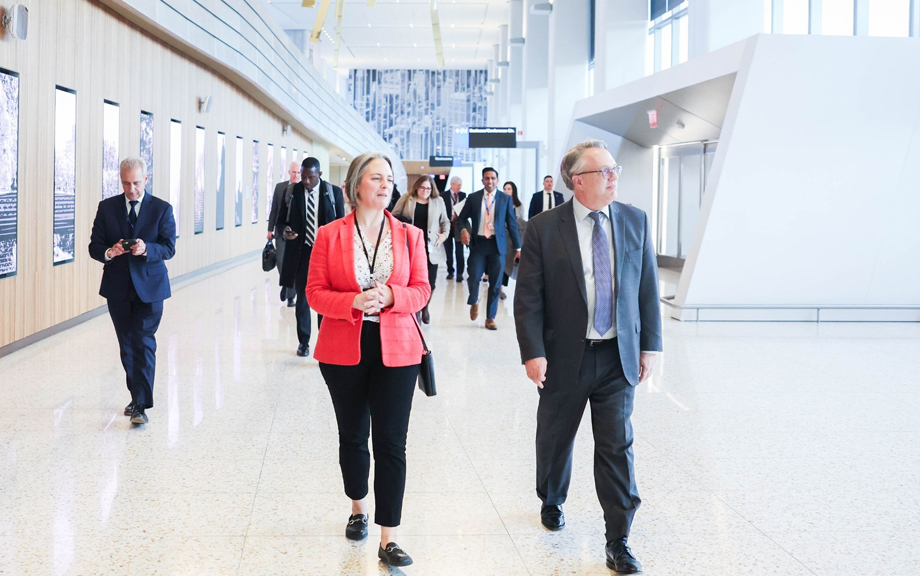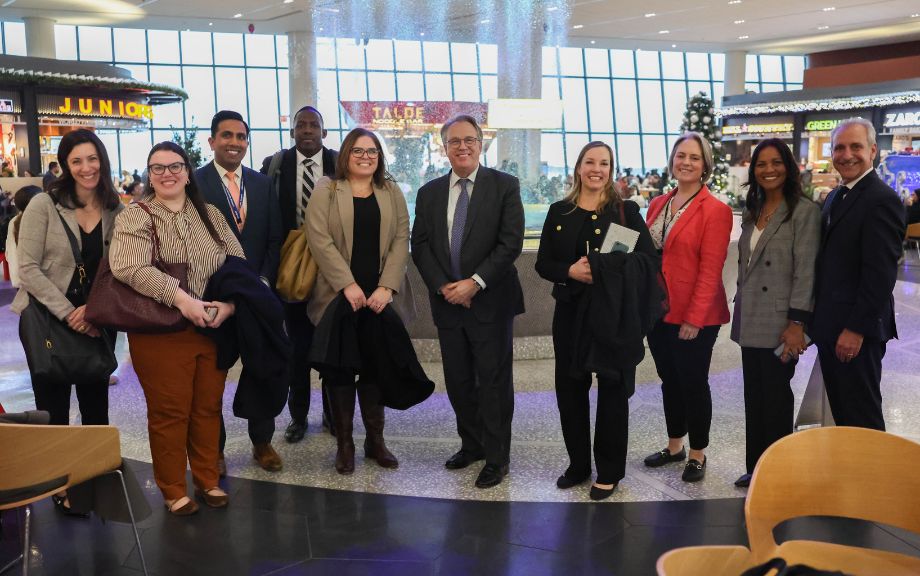
In early December, New York Fed President John C. Williams spent a day visiting neighborhoods in the New York City borough of Queens. In Long Island City, Flushing, and East Elmhurst, President Williams and a team from the New York Fed met with leaders in government, transportation, community development, and business. This regional visit—part of the New York Fed’s ongoing efforts to assess economic conditions across the Federal Reserve’s Second District—gave President Williams an opportunity to engage directly on issues specific to these communities.
With nearly 2.3 million residents, Queens is the second most populous New York City borough after Brooklyn. It is also one of the most ethnically diverse counties in the United States. While many residents commute into Manhattan for work, there are more than 750,000 people employed within the borough across a range of industries. The healthcare sector is an important driver of jobs in the borough, and transportation’s share is twice the national average, in part because Queens is home to two of the region’s major airports.
Here are some of the themes that emerged during the day’s discussions:
Affordability Challenges for Households and Businesses
Stakeholders across all backgrounds noted that housing affordability is a major concern in Queens communities. About half of Queens households rent their home, which is higher than the national average, although a little lower than in New York City overall. More than half of Queens renters are rent-burdened, meaning more than 30 percent of their income goes toward housing.
One project that stakeholders noted might lead to improved housing affordability is the redevelopment of Willets Point. Once complete, the project is expected to add 2,500 units of affordable housing. The project also includes new retail space, open public space, a hotel, and a new stadium for Major League Soccer club New York City FC. (The groundbreaking for the privately financed stadium took place the same week as our visit, and there was a lot of enthusiasm around what it might bring when it opens in 2027.)
We also heard about the high cost of doing business, for small and large companies alike. Stakeholders said that new developments often are centered on larger retail spaces—the kind that might house a “big box” store—with rents that are too high for smaller businesses. One idea that was shared was for developers to consider breaking up these spaces or making modular spaces to attract businesses of varying sizes. Stakeholders noted that smaller, locally owned businesses already face challenges from the largest competitors, whose businesses and operations have grown since the pandemic.
Meanwhile, the challenges for larger businesses are layered. First, it is more expensive to do business in Queens than in many other parts of the country: The higher cost of living pushes up the cost of labor, and construction and other operational costs are also higher. Further, New York City’s population density and coastal geography complicate the logistics for expansion. We heard about how these challenges can impede large-scale projects—such as the Willets Point development or expansions at the two airports—and thereby hinder growth. Given the elevated cost of doing business, some business leaders shared concerns about the potential effects of congestion pricing for Manhattan traffic (a program that had not yet started as of our visit in December).

Developing New Economic Hubs
Across our engagements, we heard how Queens is developing into a destination in its own right, with communities that offer the ability to live, work, and play. Though many residents still commute, more commercial and cultural activity is shifting to the borough, meaning there may be less of a need for residents to travel into Manhattan.
For example, the largest Chinatown in New York City was once in Manhattan, but now is in Flushing. Stakeholders said that in addition to shifts in population, businesses that were once centered in Manhattan, such as those in the garment industry, have moved to Queens. Community leaders in Flushing are working to attract more tourists, and the community has leaned into its “destination” status by promoting local businesses and creating food guides, like one for bubble tea.
Infrastructure Investments and Economic Development
One of the area’s most significant infrastructure developments in recent years was the $8 billion renovation of LaGuardia Airport. LaGuardia has a small footprint—it is only one square mile—but it serves around 30,000 flights per month. The effort to modernize faced unique logistical challenges, as the airport was fully rebuilt while maintaining its high volume of operations. Leaders from the Port Authority of New York and New Jersey said the renovated facilities were designed to encourage travelers to arrive early and enjoy the amenities, making the airport a destination in itself. With local concessions and public art, the Port Authority aims to provide travelers with a flavor of Queens and New York City more broadly. And the investment seems to be paying off: LaGuardia went from “worst to first” in awards announced last year.

Looking Ahead
Throughout our day in Queens, we heard optimism about the borough’s future and the creativity its communities bring to problem-solving. Discussions about potential opportunities touched on the initiative of local entrepreneurs, the commitment of community banks to providing capital, and the promise of large-scale procurement for boosting business activity. In addition, officials are leveraging the borough’s uniquely international population to make connections across the globe to expand tech and innovation investments.
Suzanne Elio is the head of corporate communications at the New York Fed.
Andrea Grenadier is an associate director of external engagement in the Communications and Outreach Group at the New York Fed.
Shawn Phillips is the head of external engagement in the Communications and Outreach Group at the New York Fed. She is responsible for broadening and deepening relationships with civic, business, academic, and other stakeholders within the Federal Reserve’s Second District.
The views expressed in this article are those of the contributing authors and do not necessarily reflect the position of the New York Fed or the Federal Reserve System.










